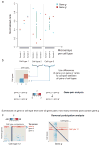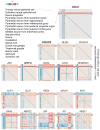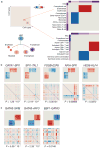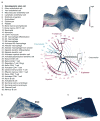Gene-pair expression signatures reveal lineage control
- PMID: 23603899
- PMCID: PMC4131748
- DOI: 10.1038/nmeth.2445
Gene-pair expression signatures reveal lineage control
Abstract
The distinct cell types of multicellular organisms arise owing to constraints imposed by gene regulatory networks on the collective change of gene expression across the genome, creating self-stabilizing expression states, or attractors. We curated human expression data comprising 166 cell types and 2,602 transcription-regulating genes and developed a data-driven method for identifying putative determinants of cell fate built around the concept of expression reversal of gene pairs, such as those participating in toggle-switch circuits. This approach allows us to organize the cell types into their ontogenic lineage relationships. Our method identifies genes in regulatory circuits that control neuronal fate, pluripotency and blood cell differentiation, and it may be useful for prioritizing candidate factors for direct conversion of cell fate.
Figures





Comment in
-
Panning data for gold: the search for master regulators of cell fate.Nat Methods. 2013 Jun;10(6):476-7. doi: 10.1038/nmeth.2491. Nat Methods. 2013. PMID: 23722206 No abstract available.
References
-
- Alberts B, et al. Molecular Biology of the Cell. 3E. Garland Science; New York: 1994. Cells and Genomes; p. 1408.
-
- Zhou JX, Huang S. Understanding gene circuits at cell-fate branch points for rational cell reprogramming. Trends Genet. 2010;27:55–62. - PubMed
-
- Kauffman SA. Control circuits for determination and transdetermination. Science. 1973;181:310–8. - PubMed
-
- Kauffman SA, Shymko RM, Trabert K. Control of sequential compartment formation in Drosophila. Science. 1978;199:259–70. - PubMed
Publication types
MeSH terms
Grants and funding
LinkOut - more resources
Full Text Sources
Other Literature Sources

